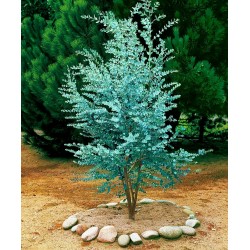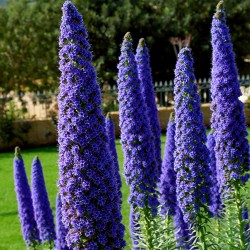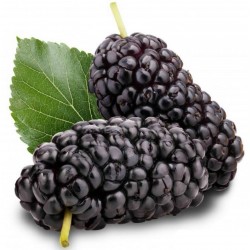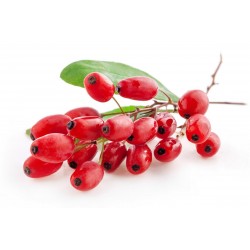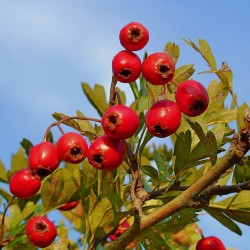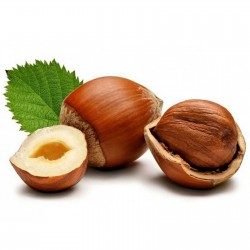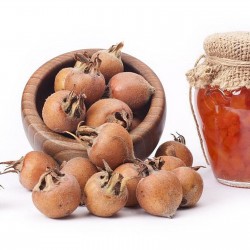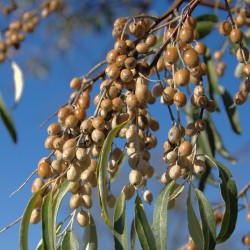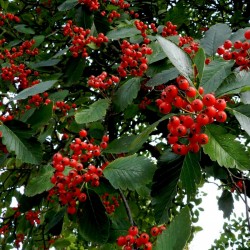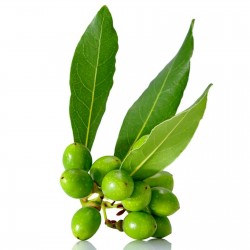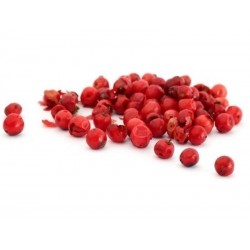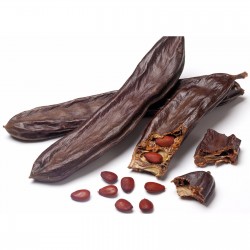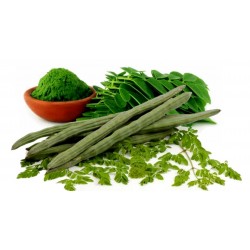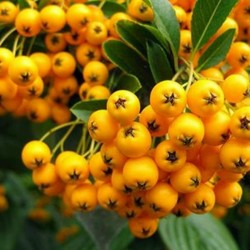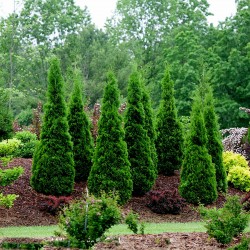Seeds Gallery EU,
5/
5
<!DOCTYPE html>
<html>
<head>
<meta http-equiv="Content-Type" content="text/html; charset=UTF-8" />
</head>
<body>
<div id="idTab1" class="rte">
<h2><span style="font-size: 14pt;"><strong>Moringa the Miracle Tree Seeds (Moringa oleifera PKM 1)</strong></span></h2>
<h2><span style="color: #ff0000; font-size: 14pt;"><strong>Price for Package of 5 or 10 seeds.</strong></span></h2>
<p>For those of you who have never heard of Moringa, at all --- we'll just give you a really quick education on it. Moringa Oleifera is the most commonly known variety of Moringa, and it has been grown in many countries, worldwide for thousands of years. Moringa Oleifera, the variety with which most people are familiar, is a slender tree, loaded with long, delicate-looking branches, which are covered with small, oval-shaped dark green leaves. Those lovely leaves are just packed with healthy, and tasty, nutrients. It is basically a tropical tree, but with care, it can be grown just about anywhere. It does NOT like the cold, so in areas where the temperatures get into the 40's, it needs to be kept warm. When the temperatures average in the low 60's, they tend to lose their leaves, and look a bit sickly. When the temperatures rise, they thrive! Ours made it through several winters here in FL, when the temperatures got as low as 28 degrees F, but we kept them sprinkled with water several times a day, and ran Christmas-type lights up, around and between the rows of seedlings.</p>
<p>The Moringa Oleifera tree can reach great heights, left to itself, but that puts its harvest WAY out of reach. Ideally, they should be kept to 6-12 feet, maximum, so you can easily prune the branches,</p>
<p>cut the flowers, and harvest the pods. You can plant the seeds in a row, and maintain the Moringa Oleifera plants as a low hedge, if all you want to do is eat the leaves. They will provide you with abundant greens, as the more you trim them - the faster they seem to grow, the more branches they put out, and the bushier they get. If you do not prune them, the leaves will be hard to reach.</p>
<p>Moringa Oleifera seeds are round and brown with tan "frilled" edges, while the seeds of the Moringa Stenopetala are a light tan, with a shape reminiscent of almonds or pistachios. Click on the bottom box on the right side of the page, to see the differences. It is unusual to see how different the seeds are, for a tree that is still Moringa. The little thumbnail photos above enlarge when you click on them</p>
<p><strong><em>WIKIPEDIA:</em></strong></p>
<p>Moringa oleifera is the most widely cultivated species of the genus Moringa, which is the only genus in the family Moringaceae. English common names include: moringa,[2] drumstick tree[2] (from the appearance of the long, slender, triangular seed-pods), horseradish tree[2] (from the taste of the roots, which resembles horseradish), ben oil tree or benzoil tree[2] (from the oil which is derived from the seeds). It is a fast-growing, drought-resistant tree, native to the southern foothills of the Himalayas in northwestern India, and widely cultivated in tropical and sub-tropical areas where its young seed pods and leaves are used as a vegetable.</p>
<p><strong>Description</strong></p>
<p>Moringa oleifera is a fast growing, evergreen, deciduous tree. It can reach a height of 10–12 m [5] and the trunk can reach a diameter of 45 cm.[6] The bark has a whitish-grey colour and is surrounded by thick cork. Young shoots have purplish or greenish-white hairy bark. The tree has an open crown of drooping, fragile branches and the leaves build up a feathery foliage of tripinnate leaves.</p>
<p>The flowers are fragrant and bisexual, surrounded by five unequal thinly veined yellowish-white petals. The flowers are approximately 1-1.5 cm long and 2 cm broad. They grow on slender hairy stalks in spreading or drooping later flower clusters which have a longitude of 10–25 cm.[5]</p>
<p>Flowering begins within the first six months after planting. In seasonally cool regions, flowering will only occur once a year between April and June. In more constant seasonal temperature and with constant rainfall, flowering can happen twice or even all year-round.</p>
<p>The fruit is a hanging, three-sided brown capsule of 20–45 cm size which holds dark brown, globular seeds with a diameter of approximately 1 cm. The seeds have three whitish papery wings and are dispersed by wind and water.</p>
<p>In cultivation, it is often cut back annually to 1–2 meters and allowed to regrow so the pods and leaves remain within arm's reach.</p>
<p><strong>Cultivation</strong></p>
<p>The moringa tree is grown mainly in semiarid, tropical, and subtropical areas, corresponding in the United States to USDA hardiness zones 9 and 10. It grows best in dry sandy soil and tolerates poor soil, including coastal areas. As with all plants, optimum cultivation depends on producing the right environment for the plant to thrive. Moringa is a sun and heat-loving plant, and thus does not tolerate freeze or frost. Moringa is particularly suitable for dry regions, as it can be grown using rainwater without expensive irrigation techniques.</p>
<p><strong>Production area</strong></p>
<p>As of 2010, cultivation in Hawaii, for commercial distribution in the United States, is in its early stages.</p>
<p>"India is the largest producer of moringa, with an annual production of 1.1 to 1.3 million tonnes of tender fruits from an area of 380 km². Among the states, Andhra Pradesh leads in both area and production (156.65 km²) followed by Karnataka (102.8 km²) and Tamil Nadu (74.08 km²). In other states, it occupies an area of 46.13 km². Tamil Nadu is the pioneering state in·so·much as it has varied genotypes from diversified geographical areas and introductions from Sri Lanka."</p>
<p>Moringa is grown in home gardens and as living fences in Southern India and Thailand, where it is commonly sold in local markets.[11] In the Philippines, it is commonly grown for its leaves which are used in soup. Moringa is also actively cultivated by the World Vegetable Center in Taiwan, a center for vegetable research with a mission to reduce poverty and malnutrition in developing countries through improved production and consumption of vegetables. Tamil Nadu, Southern India has moringa in its folk stories and use in home gardens. In Haiti it is grown as windbreaks and to help reduce soil erosion.</p>
<p><strong>Cultivation practice</strong></p>
<p>Moringa can be grown as an annual or perennial plant. In the first year all pods are edible. Later years also bear non edible bitter pods. Therefore Moringa is often commercially cultivated annually. On less favorable locations the perennial cultivation has big advantages. Erosion is much smaller with perennial cultivation.[13] Perennial cultivation of Moringa is also practiced in agroforestry.</p>
<p><strong>Soil preparations</strong></p>
<p>In tropical cultivation sides the soil erosion is a major problem. Therefore the soil treatment has to be as low as possible. Plowing is required only for high planting densities. In low planting densities "it is better to dig pits and refill them with the soil. This ensures good root system penetration without causing too much land erosion. The pits must be 30 to 50 cm deep, and 20 to 40 cm wide."</p>
<p><strong>Propagation</strong></p>
<p>Moringa can be propagated from seed or cuttings. Direct seeding is possible because the germination rate of Moringa oleifera is high. After 12 days the germination rate is about 85%.[8] Production in seedbeds or containers is very time consuming. In these technics the plants can be better protected from insects and other pests. They are also used in areas where soil erosion is a problem.</p>
<p>Cuttings of 1 meter length and a diameter of at least 4 cm can be also used for propagation.[8] At least one third of the cutting must be buried in the soil. In the Philippines, moringa is propagated by planting 1–2 m-long limbs cuttings, preferably from June to August. It can also be propagated by seeds, which are planted an inch below the surface and can be germinated year-round in well-draining soil.</p>
<p><strong>Planting</strong></p>
<p>For intensive leaf production "the spacing of plants should be 15 x 15 cm or 20 x 10 cm, with conveniently spaced alleys (for example: every 4 meters) to facilitate plantation management and harvests. Another option is to space the seeding lines 45 cm apart and to sow every 5cm on those lines. One can also space the lines only 30 cm apart and sow at a larger distance on the lines (10 to 20 cm)".[8] Weeding and disease prevention are difficult because of the high density.</p>
<p>In a semi-intensive production the plants are spaced 50 cm to 1 m apart. This gives good results with less maintenance.</p>
<p>Moringa trees can also be cultivated in alleys, as natural fences and associated with other crops. The distance between moringa rows in an agroforestry cultivation are usually between 2 to 4 meters.[8]In Haiti it is being used as fencing and windbreaks on farms.</p>
<p><strong>Breeding</strong></p>
<p>In India, from which Moringa most likely originates, the diversity of Moringa in cultivars in wild types is large.[13] This gives a good basis for breeding programs. In countries where Moringa has been introduced as a cultivar, the diversity is usually much smaller among the cultivar types. Locally well adapted wild types on the other hand, can be found in most regions.</p>
<p>Because Moringa is cultivated and used in different ways, exist different breeding aims. The breeding aims for an annual or a perennial plant are obviously different. The yield stability of fruits are an important breeding aim for the commercial cultivation in India where Moringa is cultivated annually. On less favorable locations the perennial cultivation has big advantages. Erosion is much smaller with perennial cultivation.[13] Perennial cultivation of Moringa is also used in agroforestry. In Pakistan varieties have been tested for their nutritional composition of the leaves on different locations.[14] The different breeding aims result in a different selection. India selects for a higher number of pods and dwarf or semi-dwarf varieties. Breeders in Tanzania on the other hand are selecting for a higher oil content.[15] In total, only little breeding has been achieved so far.</p>
<p><strong>Yield and Harvest</strong></p>
<p>Moringa oleifera can be cultivated for its leaves, pods and/or its kernels for oil extraction and water purification. The yields vary widely, depending on season, variety, fertilization, and irrigation regime. Moringa yields best under warm, dry conditions with some supplemental fertilizer and irrigation.[16] Moringa harvest is done manually with knifes, sickles and stabs with hooks attached to it.</p>
<p><strong>Fruits</strong></p>
<p>When the plant is grown up from cuttings the first harvest can already take place after 6-8 month after plantation. Often, the fruits are not yielded in the first year and the yield is generally low during the first years. By year 2 it produces around 300 pods, by year 3 around 400-500. A good tree can yield 1000 or more pods.[17] In India a hectare can produce 31 tons of pods per year.[16] Under North Indian conditions the fruits ripen during the summer. Sometimes, particularly in South India, flowers and fruits appear twice a year and so there are 2 harvests, in July to September and March to April.</p>
<p><strong>Leaves</strong></p>
<p>Average yields of 6 tons/ha/year in fresh matter are can be achieved. The harvest differs strongly between the rainy and dry season with 1120 kg/ha per harvest and 690 kg/ha per harvest. The leaves and stems can be harvested from the young plants 60 days after seeding and then another 7 times in the year. At every harvest the plants are cut back to within 60 cm of the ground.[19] In some production systems the leaves are harvested every 2 weeks. Foidl. et al. (2001) showed that the cultivation of Moringa oleifera can also be done intensively with irrigation and fertilization with suitable varieties. Trials in Nicaragua with 1 million plant/ha and 9 cuttings/year over 4 years gave an average fresh matter production of 580 metric tons per ha/year equivalent to about 174 metric tons of fresh leaves.</p>
<p><strong>Oil</strong></p>
<p>One estimate for yield of oil from kernels is 250 liters per hectare.[16]The oil can be used as a food supplement, as a base for cosmetics and for hair and the skin.</p>
<p><strong>Pests and diseases</strong></p>
<p>The moringa tree is not affected by any serious diseases in its native or introduced ranges.</p>
<p>In India there are several insect pests, including various caterpillars such as the bark-eating caterpillar, the hairy caterpillar or the green leaf caterpillar. The budworms Noctuidae are known to cause serious defoliation. Damaging agents can also be aphids, stem borers and fruity flies. In some regions termites can also cause minor damages. If termites are numerous in soils the insects management costs are not bearable.</p>
<p>The moringa tree is a host to Leveillula taurica, a powdery mildew which causes damage in papaya crops in south India. Cultivation management should therefore be checked.</p>
<p><strong>Leaves</strong></p>
<p>The leaves are the most nutritious part of the plant, being a significant source of B vitamins, vitamin C, provitamin A as beta-carotene, vitamin K, manganese and protein, among other essential nutrients.[22][23] When compared with common foods particularly high in certain nutrients per 100 g fresh weight, cooked moringa leaves are considerable sources of these same nutrients. See chart on the right for nutritional value for fresh leaves. See chart below for nutrional value of dried leaves.</p>
<p>Some of the calcium in moringa leaves is bound as crystals of calcium oxalate[26] though at levels 25-45 times less than that found spinach, which is a negligible amount.</p>
<p>The leaves are cooked and used like spinach. In addition to being used fresh as a substitute for spinach, its leaves are commonly dried and crushed into a powder used in soups and sauces. As with most foods, heating moringa above 140 degrees Fahrenheit destroys some of the nutritional value.</p>
<p><strong>Drumsticks</strong></p>
<p>The immature seed pods, called "drumsticks", are commonly consumed in South Asia. They are prepared by parboiling, and cooked in a curry until soft.[27] The seed pods/fruits, even when cooked by boiling, remain particularly high in vitamin C[28] (which may be degraded variably by cooking) and are also a good source of dietary fiber, potassium, magnesium and manganese.</p>
<p><strong>Seeds</strong></p>
<p>The seeds, sometimes removed from more mature pods and eaten like peas or roasted like nuts, contain high levels of vitamin C and moderate amounts of B vitamins and dietary minerals (right table, USDA).</p>
<p><strong>Seed oil</strong></p>
<p>Mature seeds yield 38–40% edible oil called ben oil from its high concentration of behenic acid. The refined oil is clear and odorless, and resists rancidity. The seed cake remaining after oil extraction may be used as a fertilizer or as a flocculent to purify water.[29] Moringa seed oil also has potential for use as a biofuel.</p>
<p><strong>Roots</strong></p>
<p>The roots are shredded and used as a condiment in the same way as horseradish; however, they contain an alkaloid, potentially having nerve-paralyzing properties.</p>
<p><strong>Malnutrition relief</strong></p>
<p>Moringa trees have been used to combat malnutrition, especially among infants and nursing mothers. Five NGOs in particular — Trees for Life International, The Christian and Missionary Alliance, Church World Service, Educational Concerns for Hunger Organization, and Volunteer Partnerships for West Africa — have advocated moringa as "natural nutrition for the tropics."[25] One author stated that "the nutritional properties of Moringa are now so well known that there seems to be little doubt of the substantial health benefit to be realized by consumption of Moringa leaf powder in situations where starvation is imminent."</p>
<p>Moringa is especially promising as a food source in the tropics because the tree is in full leaf at the end of the dry season when other foods are typically scarce.</p>
<p><strong>Culinary uses</strong></p>
<p>Moringa has numerous applications in cooking throughout its regional distribution. It may be preserved by canning and exported.</p>
<p>In Bangladesh, it is made into a variety of curry dishes by mixing with coconut, poppy seeds, and mustard or boiled until the drumsticks are semisoft and consumed directly without any extra processing or cooking. It is used in curries, sambars, kormas, and dals, although it is also used to add flavor to cutlets and other recipes.</p>
<p>The fruit meat of drum sticks, including young seeds, is used for soup. Young leaves can either be fried with shrimp or added as a topping in fish soup.</p>
<p>There are several traditional Cambodian dishes using leaves (sluc) of the moringa tree known as daum m'rum,[37] such as korko (a mixed vegetable soup). As it is a favorite vegetable, Cambodians traditionally grow moringa trees close to their residences.</p>
<p>In South India, Sri Lanka and Java, it is used to prepare a variety of sambar, is fried, or made into curry dishes by mixing with coconut, poppy seeds, and mustard or boiled until the drumsticks are semisoft and consumed directly without any extra processing or cooking. It is used in curries, sambars, kormas, and dals, although it is also used to add flavors, such as in ghee and soups. In Maharashtra, the pods are used in sweet and sour curries. In Gujarat and Rajasthan, the pods are used in to cook a spicy curry.</p>
<p>Tender drumstick leaves, finely chopped, are used as garnish for vegetable dishes and salads. It is also used in place of or along with coriander. In some regions, the flowers are gathered and cleansed to be cooked with besan to make pakoras.</p>
<p>The leaves may be fried and mixed with dried-fried tuna chips (Maldive fish), onions and dried chillies. This is equivalent to a sambal and eaten along with rice and curry. In one area in the Maldives, a soup is made with these leaves and rice, and eaten especially for breakfast during the month of Ramazan. It is also a common ingredient in an omelet. The pods are used to cook a mild curry.</p>
<p>In the Punjab region of India and Pakistan, moringa called Soanjhna flowers are first separated from the stem, boiled, mashed and cooked. Curdle is an important element of its recipe to create a specific taste and favorite dish.</p>
<p>The green pods, the leaves and the flowers are used in a variety of Thai dishes, such as curries, stir-fries, soups, omelets and salads. One of the most traditional dishes is sour Thai curry made with the drumstick pods and fish.</p>
<p>In the Philippines, moringa leaves, known as kamunggay, malunggay or marungay, are commonly added to broth as a simple soup. The leaves may also be used as a typical ingredient in tinola, a traditional chicken dish consisting of chicken in a broth, moringa leaves, and either green papaya or another vegetable or in the all vegetable dish known as utan. The leaves can also be processed with olive oil and salt for a pesto-like pasta sauce that has become popular on the Filipino culinary scene. Moringa juice may be mixed with lemonsito juice to make ice candies or cold drinks, possibly more palatable to those who dislike vegetables.</p>
<p>In 2007, Filipino Senator Loren Legarda campaigned for the popularization of moringa. She asked the government to make moringa among its priority crops for propagation, citing a Bureau of Plant Industry report about moringa's nutritional content.[38][39] The leaves may also be used in making polvoron (a milky, powdered snack), biofuel, and ben oil.</p>
<p><strong>Other uses</strong></p>
<p>In developing countries, moringa has the potential to improve nutrition, boost food security, foster rural development, and support sustainable landcare.[35] It may be used as forage for livestock, a micronutrient liquid, a natural anthelmintic and possible adjuvant.</p>
<p>Moringa has been used in folk medicine,[36] including Siddha medicine and Ayurvedic traditional medicines and in the Philippines.[43] In Ayurvedic traditional medicine, the leaves are believed to affect blood pressure and glucose levels.[44] In Africa, Indonesia and Philippines, moringa leaves are given to nursing mothers in the belief that they increase lactation.</p>
<p><iframe width="640" height="385" src="https://www.youtube.com/embed/txbXMGnCERU?rel=0&hd=1" frameborder="0" class="embed-responsive-item"> </iframe></p>
</div>
</body>
</html>
T 38 10S

